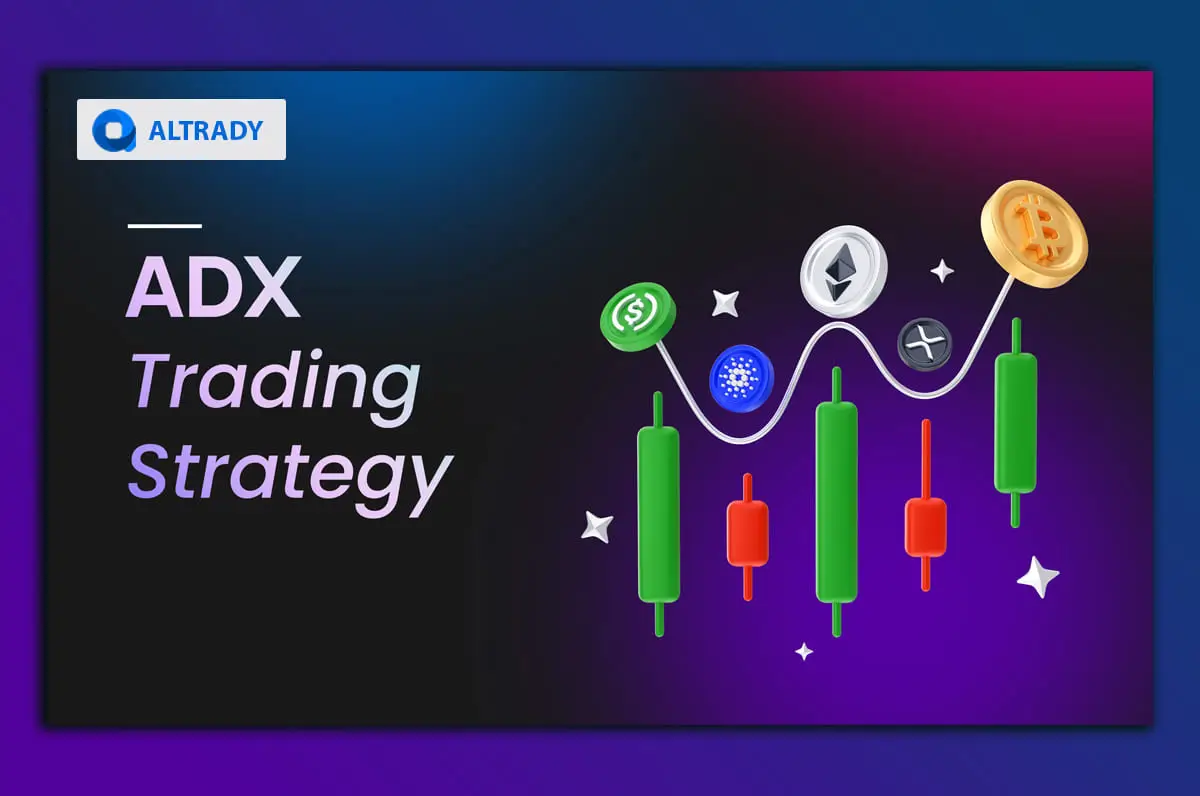Black Friday is loading…
Get 40% off with Altrady’s yearly plan and take the lead.
.svg)
.svg)
.svg)
.svg)
.svg)
.svg)
.svg)
.svg)
.svg)
.svg)
.svg)
.svg)
.svg)

ADX stands for Average Directional Index, and it primarily measures the strength of a trending market. It works on a moving average that tracks the range expansion of the price of an asset in a given period. We will dive deeper into this article to understand how it works and benefits cryptocurrency traders from a swing, intraday, and investment perspective. You can then test it on paper trading with an edge on it.

It is not a momentum oscillator but uses price impulse as data. It is not a volatility indicator but can provide insights into buyers' and sellers' activity when it works with the Directional Movement Indicator (DMI).
It is ultimately a trend trading indicator that gauges the strength of the price action regardless of the market direction.
The moving average that ADX plots is a 14-period that moves between values from 0 to 100.
| Value | Indicator |
|---|---|
| 0-25 | Weak Trend |
| 25-50 | Strong Trend |
| 50-75 | Strong Sustainable Trend |
| 75-100 | Powerfully Trending Market |
By itself solely, ADX is a single line oscillating between the values expressed previously. However, a typical use comes with the DMI. In that case, traders can have a more advanced approach to measuring trend strength.
DMI and ADX can be up to 4 lines:
Typically, traders use three of them: +DI, -DI, and DX. This way, they measure the demand and supply alongside their strength:
It can seem complex, but it is not. If you already understand the MADC, the DX line is like the histogram that increases and decreases when the MACD and signal lines separate or narrow.
Finally, the ADX indicates the average of all the three.
Crypto markets are known and attractive for their intrinsic volatility and sharp moves. From a very long-term perspective, large-cap crypto coins like BTC and ETH have been trending upward ever. Farther from the volatility conditions, ADX could have assisted investors in unveiling the strength of those primary coins trending markets.
However, crypto traders should be aware of the actual application of ADX and not miss the central concept: measuring the likelihood for a market to remain trending. In this sense, trying to get a signal for a short-term buying or selling approach could not be the most accurate implementation.
Likewise, attempting to conduct a chart reading based on a directional move is the wrong application, and it is so for crypto assets, whose underlying speculative nature makes it hard for the market to find a clear direction and start trending.
To understand ADX in this context, we should study each trading style.

ADX is naturally a lagging indicator, while scalping is a high-frequency and fast-execution trading style. From these two definitions, we can already intuit an answer: it is not precisely the best indicator for scalping.
However, as trading is an all-possible activity, surely there could be creative ways to use it from a very short-term standpoint along with other indicators.
For instance, traders could use it in a short time frame as a confirmation tool for timing an entry point by measuring the strength of a particular price zone or a specific candle at an exact moment during a trend.

ADX for day trading can help traders measure the strength of a day's trend. If an asset has been on trend for several days or a notable prolonged period, day traders can use it to:
Breakouts are very common during intra-day sessions. These price movements generally occur at the session opening, range expansions, or during trend patterns like flags, pennants, and triangles. ADX can help traders measure each breakout.
Furthermore, during intraday sessions after the first hours when the price makes the primary moves, it tends to move sideways, which means in a range, most of all, before a day's reversal move, trend continuation, or, as typically does, before the afternoon sessions when end-of-day movements take place.
For swing trading, ADX represents more than an edge; we could say it is the more accurate application. Since ADX is a trend trading indicator and the most profitable trending markets last from a middle-term to long-term standpoint, we can infer how swing traders can benefit.
When swing traders enter a position, they no longer care for momentum or direction as much as for how long the current trend will last. For a trend to prolong in time, it needs strength.
A strengthening trend indicates a healthy supply if it is going down or demand if it is going up, and that is what a swing trader needs to maintain a position for days or weeks.
So, swing traders can use ADX such as follows:
Long-term investors build portfolios integrating multiple assets from different industries. This type of investment benefits solely from the following:
Each asset may have its characteristic volatility and momentum. As with swing traders, the most essential thing for investors is the probability that a trending asset will continue over time.
As far as we know, ADX accomplishes that task. Indeed, stock investors are well-known users of this indicator while they manage their stock portfolios.
ADX is a straight-trend trading indicator with powerful and versatile applications. Traders can use it for different styles while maintaining its central concept. Also, they can implement it in combination with DMI for a more advanced approach.
In Altrady, crypto traders can benefit by using the DMI and ADX. Sign up for a free trial account today, and do not miss the opportunity to measure the strength of crypto assets.